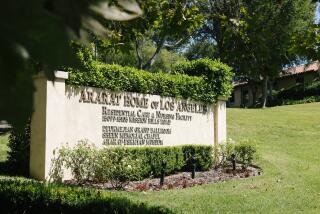Hospital Faces Check for Full Accreditation : Thousand Oaks: Earlier inspection faulted Los Robles Regional Medical Center’s record-keeping. But an official says standards will be met this time.
- Share via
The nation’s major hospital accreditation organization will inspect Los Robles Regional Medical Center next month to determine whether to restore the center’s full accreditation.
The inspection will be the Thousand Oaks hospital’s fourth in less than two years by the Joint Commission on Accreditation of Healthcare Organizations. Previously, the commission has cited Los Robles for failing to meet filing and record-keeping standards.
After the commission’s most recent visit in January, inspectors placed the hospital on conditional accreditation for falling short of the commission’s record-keeping standards for autopsies and patient restraint.
“Frankly, we feel it is ridiculous for them to deal with (the problems) in the manner they have,” said Robert Quist, the hospital’s administrator. “It’s embarrassing to us, and we feel that we have served the community well for 25 years.”
With 220 beds, Los Robles is one of Ventura County’s largest hospitals. It is owned by Hospital Corp. of America, a for-profit company.
All of Ventura County’s other hospitals, as well as Westlake Community Hospital in Westlake Village, are accredited, said a commission spokesman.
David Langness, a spokesman for the Hospital Council of Southern California, said record-keeping problems are the usual reason when hospitals receive a conditional accreditation, and should throw no blight on the institution’s medical reputation. “It happens all the time,” he said.
Because the federal government also uses accreditation as a qualifier for a hospital’s participation in Medicare and Medicaid programs, the commission looks for strict compliance with often highly detailed federal regulations. The commission is not a federal regulatory organization, however, but rather a nonprofit corporation supported by hospital education and inspection fees.
Physicians and others familiar with the commission’s accreditation process said that while an accreditation denial is always a very serious matter, conditional accreditation varies in significance, depending on its cause.
Los Robles does not participate in the Medicaid program. Should inspectors deny it accreditation in July, however, it could encounter a host of troubles. For example, hospitals that lose their accreditation often face higher liability insurance rates and have lower bond ratings than accredited institutions, said Gary Snyderman, a commission spokesman.
But Quist, Los Robles’ administrator, said he feels assured that this time the hospital will meet the commission’s standards.
One of the commission’s citations was for not properly recording autopsy decisions. Physicians must ask patients’ families immediately after a patient’s death whether they want an autopsy performed. The commission requires that the family’s answer be immediately recorded in the medical records.
Quist said that although doctors inquired about autopsies on the day of the death, the hospital did not require them to make note of the family’s response until 30 days afterward. This has since been corrected, he said.
The second citation concerned doctors’ orders for continuation of patient restraints. Hospitals occasionally use cloth restraints on disoriented patients to prevent them from falling out of bed, pulling out intravenous tubing, or otherwise harming themselves.
The hospital previously allowed doctors to merely limit the maximum amount of time any patient might be placed in restraints. It now complies with commission regulations stipulating that doctors must continue to periodically sign off on the restraints during the course of a day, Quist said.
Quist said the first citation stemmed from repeated misunderstandings between the hospital staff and commission inspectors over the precise nature of the regulation. The hospital received the restraint citation, he said, because it was unaware that the commission altered its regulation between its October, 1991, and October, 1992, inspections, and again between its October, 1992, and January, 1993, inspections.
“The joint commission’s administration and rules come out like the Federal Register sometimes,” he said, referring to the dense, finely printed book published daily by the federal government, listing all new laws and regulations.
More to Read
Sign up for Essential California
The most important California stories and recommendations in your inbox every morning.
You may occasionally receive promotional content from the Los Angeles Times.










